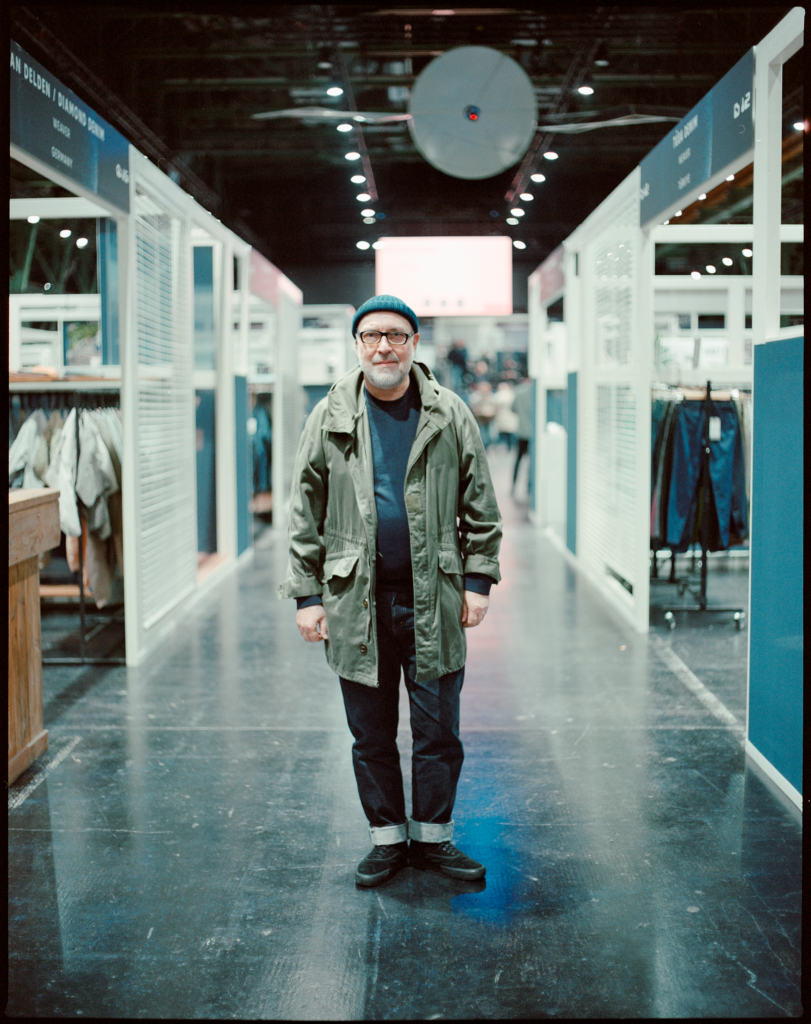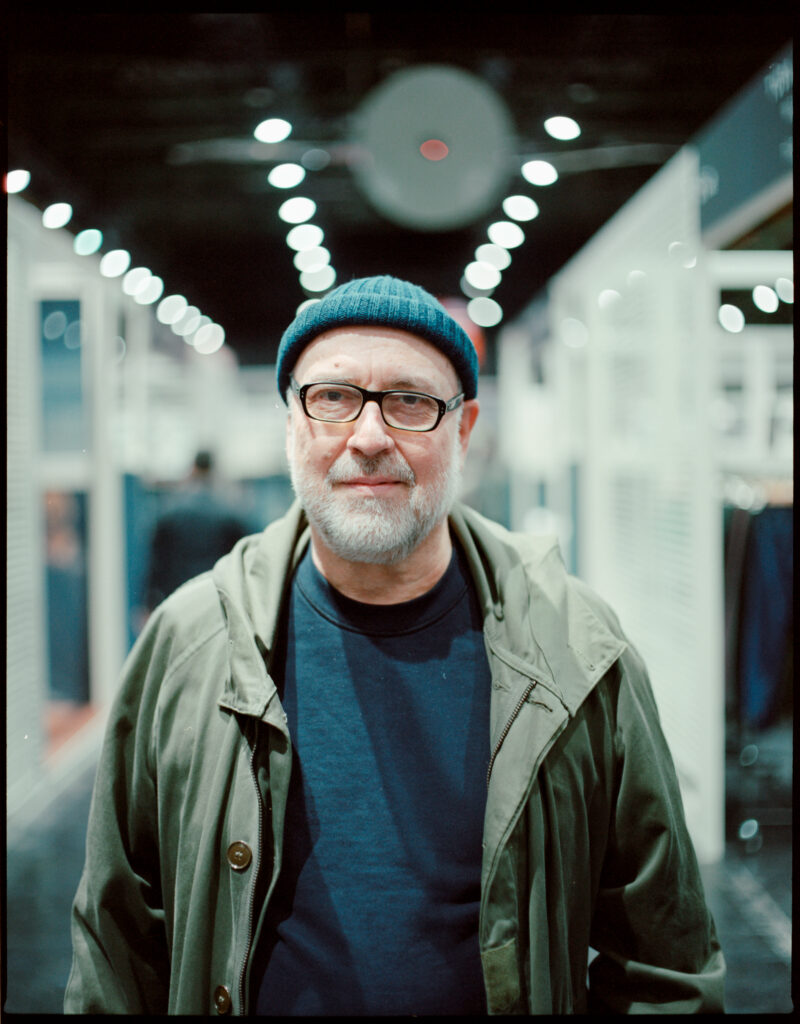
The Bluezone Q&A introduces
Panos Sofianos
Meet Panos Sofianos, a seasoned denim guru born in the early fifties in a small Greek town near the Bulgarian borders. As the third child of a creative mother, Panos grew up watching his mother lovingly repair the family’s coats, transforming them into warm jackets. Seeing this instilled in him a natural inclination towards reuse.
In the late 1960s, Panos acquired his very first pair of jeans and a jacket made of Pinto Denim, manufactured by Cone. Although they were imitation Lee jeans, complete with four external square pockets, they held a special place in his heart as they were proudly made in Greece. The encounter with the pair sparked a deep and long-lasting love for denim that is with him still.
When it comes to unwinding and rejuvenating, Panos finds solace in cooking with passion and adding unconventional spices and herbs to traditional dishes. A connoisseur of Martini dry and fine wines, a film noir enthusiast, and a fan of small cigars and aged Puerto Rican Rum, Panos’s ideal vacations are spent on the picturesque Greek island of Lemnos, near the Turkish coast, where fresh seafood is mixed with local products like dried cheese and homemade pasta.
We recently sat down with Panos and talked about the world of denim and his place in it.

Q&A
Q: Can you tell me a little bit about your background and experience? What is the role you play in the denim industry?
A: After pursuing Marketing studies at the University of Salonica in Greece – I never got my diplomas – I made the decision to join my cousins’ jeans manufacturing company. This choice allowed me to travel to Italy to work for brands like Americanino, Ufo, Diesel and Replay. During these trips I met my mentors, Adriano Goldschmied, Renzo Rosso, and Claudio Buziol, who transmitted their passion for denim.
I relocated to Athens and contributed to renowned brands like Lee Cooper, Lois from Spain, and many others. In the late ‘90s, I was recruited by Hellenic Fabrics in Pella, Greece, where I worked in Product Development, supplying unique denims to esteemed brands like Levi’s, Diesel, and Liberto. Driven by my passion for language acquisition, I eventually moved to Spain and assumed the role of creative director at Tejidos Royo. It was during this time that I had the privilege of creating Denim Valley, the first sustainable iconic brand, supplying esteemed names like G-Star, Kings of Indigo, Hugo Boss, Pepe Jeans, and many more.
Q: What initially attracted you to the world of denim? What keeps you passionate about it?
A: Denim is the one fabric with a million and one faces and looks.
Q: Could you describe a typical workday in your professional routine? What are the key activities and responsibilities that fill your schedule?
A: This is more than just a typical workday; it’s a 24-hour job. It involves constantly envisioning new concepts, exploring innovative raw materials, refining processes, experimenting with shades, and discovering new end uses. The creative journey never stops, demanding dedication and a ceaseless pursuit of inspiration.
Q: From your perspective, which current trends and innovative advancements do you consider to be the most significant in shaping the denim industry?
A: Our foremost challenge lies in minimizing the environmental impact of denim production. Like many other manufacturers of everyday products, we must acknowledge that we have been significant contributors to environmental issues.
Q: Looking ahead, what do you foresee as the challenges and opportunities for the denim industry?
A: Our approach focuses on producing less, prioritizing reuse, and upholding ethical values. We strive for authenticity and transparency in our practices. Rather than seeking constant growth, our goal is to ensure survival while maintaining our commitment to responsible and sustainable principles.
Q: If you had the opportunity to make a single change in the denim industry, what aspect would you choose to transform?
A: Our focus is on utilizing material fibers with a circular origin. Additionally, we employ wet treatment methods that allow for general treatment without negatively affecting the environment.
Q: In your experience, how has the denim industry evolved over the last 20 years? What significant changes have you observed?
A: The industry has undergone a remarkable transformation, similar to the evolution witnessed in Silicon Valley. We have shifted from utilizing synthetic indigo and cotton to embracing waste fibers and dry dye systems. In the past, methods such as pumice stones, sand blasting, and chlorine were prevalent, but now we have advanced techniques like ozone and laser technology. While this progress is significant, there are still some essential elements missing if we are to achieve a fully sustainable and environmentally friendly supply chain.
Q: What is your opinion of the Bluezone shows and their impact on the denim industry?
A: We are dedicated to tirelessly pursuing our mission of creating a better industry by actively educating and communicating with our members about the latest innovations. Keyhouse, as the pioneering hub among shows, serves as a platform to promote new material fiber concepts, processes, and systems. We strive to foster a collaborative environment where groundbreaking ideas are shared and embraced, driving the industry towards a brighter and more sustainable future.
Q: As Bluezone celebrates its 20th anniversary, what message or sentiment would you like to convey to the organization to mark this significant milestone?
A:We remain committed to our ongoing efforts of connecting individuals with innovative ideas and methodologies, all aimed at fostering a braver and more sustainable denim industry. We recognize that the world does not solely belong to us; rather, we have borrowed it from future generations. With this in mind, we are driven to create a positive impact that will resonate for years to come, ensuring a better world for our children’s children.